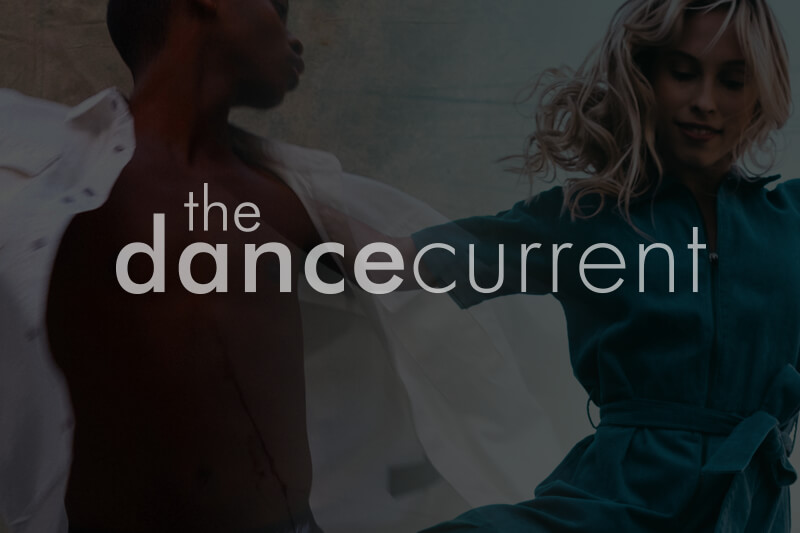The sun is high on the steps overlooking Place des Arts in Montréal, and Chantal Caron’s piece Hommes de vase, which translates to Clay People, unfolds on the sidewalk-turned-stage. Her work, with Fleuve | Espace danse, is one of many outdoor performances organized by the Festival Quartiers Danses, now in its fourteenth year. Four of Caron’s dancers in nude underwear covered in grey mud perform a ritual surrounded by a slow-moving chorus of dancers in grey hooded suits. The audience was a second chorus, creating a halo of un-choreographed movement around the clay people as they walked around, paused or sat to watch. The ambling audience and the hooded dancers created a calm undercurrent of movement that contrasted the four sinewy and trembling protagonists.
Caron’s piece was followed by À chaque vent le papillon se déplace sur le saule by Julie Dossavi. As Dossavi began to dance, the public chatted and some walked around. Nothing holds the audience responsible for engaging with a work during free outdoor performances, and artists adapt in their way to this reality. Instead of demanding attention, Dossavi let her soundscape and her unadorned gestures accumulate momentum by repetition. She took her time and calmly transformed the space into an inviting if ephemeral world of sound and sensation. The intentionality of her movements within that world highlighted how each gesture, sound and gust of wind impacts our experience of the present moment.
Part of the mandate of the festival is to facilitate the discovery of original work by emerging artists and encourage those less familiar with contemporary dance to test the waters. The outdoor programming and in-theatre shows with shared bills enabled audiences to see multiple works, giving them the opportunity to nurture their opinions and curiosity. This year, both the programming and the round-table discussions addressed major themes in dance including joy, the experience and memories of seasoned women artists on stage, the revival of past works, the inclusion of diverse bodies often excluded from dance and accessibility for audiences.
The Local Emerging Artists II program on September 15 featured fresh works such as De notre petit squelette by Annabel Boissonneault and Alya Graham about the gentle but dominating power of vertigo in large empty spaces. Boissonneault and Graham drew inspiration from nature and high mountain peaks and balanced their vulnerability in the face of an immense environment with strong physicality. Throughout, they caught one another falling with precision and climbing with a fluid quality through the space as if in awe and admiration rather than fear toward the world’s vast caverns and open cliffs.
The same evening, BEAUTÉ BRUTE: Volume II by LA TRESSE Dance Collective flooded the theatre with rituals and celebrations of uninhibited feminine identity. The trio of creators and performers, Geneviève Boulet, Laura Toma and Erin O’Loughlin, shuddered and contorted to a soundtrack that included folk music, disco and indistinguishable chants that echoed like the inside of a church. The audience was confronted by a blinding sun-like spotlight in the second half while Boulet transformed and peeled off the tight hooded tube of fabric encasing her: a moment that could be read as a ritualistic unveiling. The explosive power of these women was visible in the ferocity of their facial expressions with each new song. Their physicality was so extreme it bordered on absurdity, enthralling both themselves and the audience.
You Think I Think You See It This Way by Kyra Jean Green was also packed with physical intensity, using narration to examine an old problem of philosophy inspired in part by Plato’s Allegory of the Cave — the nature of reality and perception.
The theme of communication or miscommunication also dominated Jo Leslie’s work Mutable Tongues, which was presented on September 10 at Cinquième Salle at Place des Arts. It was performed by Louise Moyes and Jacinte Giroux, who suffered a stroke in 2000 that left her paralyzed in her right arm, hand, leg and foot. In the duet, Giroux stutters in her movement and speech, persistently demanding to be heard and understood as she narrates the story of Cassandra to the audience. The ancient Greek myth is the tale of a woman who carries a gift of prophecy but whose tongue is cursed so her prophecies are never believed. Mutable Tongues questions whose voices and bodies we listen to and whose we discredit. It shared a triple program with Et après…le silence by Diane Carrière and Beaux moments by Howard Richard.
The question of who we listen to and how we remember was also referenced throughout Beaux moments, bringing the colourful memories of his work with four seasoned dancers — Estelle Clareton, Nina Galea, Pascale Lalonde and France Roy — into the present. The quartet presents a system of movement and creativity that is active, patient and playful. From their knowing glances to one another and their similar but personalized costumes, red shoes and black dresses, we sense that they share a secret and beloved nostalgia.
In Et après…le Silence, Carrière makes something old new again. Dancer Sébastien Provencher performs a duet with the film of Carrière’s 1974 solo ABRÉACTION projected behind him. When Carrière herself enters the stage, another duet of the same movement vocabulary follows, this one unfolding live. Together, Carrière and Provencher offer a method of respecting the integrity of an old original work while making it relevant and alive to the present.
Many themes raised in the performances throughout the festival were discussed at the round-table event When Does Dance Become Social? co-hosted with the Art, Culture and Well-Being Research Chair at the Université du Québec à Montréal on September 16. Panelists Tim Casson, Élise Hardy and Manon Hotte created choreographies with people who normally do not have access to dance or are not considered professionals. For Casson, the joy and pride dancing fosters in non-dancers and disabled participants in his choreography The Dance WE Made is a central social element of his work. Hardy, who recently created a work with women inmates at Tanguay Detention Centre in Montréal, places high importance on the self-confidence and freedom dance brings to women in an institution like prison, an environment that is opposed to physical liberation. For Hotte, whose Compagnie Virevolte works with youth, the act of listening to young voices is key to teaching empathy and respect.
For the panel and the festival, social and democratic dance is dance that seeks to connect people. More concretely, it fights isolation across generations and cultural lines, celebrating people’s histories, elevating the joy of dance and the freedom of expression that it represents.
Tagged: Choreography, Contemporary, Festival, Performance, Montréal , QC



